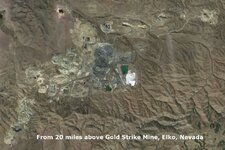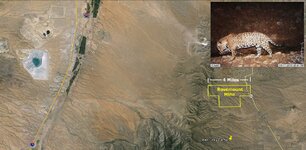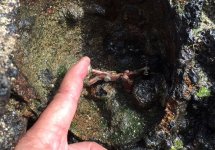On this forum, and others, I read endless stories of how mining is being shut down in the United States. Tales of mines projects being protested and lawsuits against mining seem to be popular.
I work full time in the mining industry and my experiences just don't jibe with these stories. Every year the greenies lose more cases than they win. The courts continue to rule that mining can proceed despite the protests and lawsuits.
There is some opposition in some particular areas to mining. In many other regions mining is welcomed as a revenue and job source to help struggling communities. I'm going to profile two mining projects in this post that I am very familiar with. I hope these profiles will help demonstrate how the United States remains the third largest mining nation on earth.
__________________________________________
Case #1
Probably one of the communities most opposed to any form of mining is Tucson, Arizona. This small city has become the chosen retirement destination for the bike riding, sandal wearing laid back liberals from the Northeast. It's about as anti-mining as a community can get. Any hint that a hole might be dug in Mother Earth somewhere brings out the opposing petitions, and checkbooks, of these wealthy retirees. It's not a coincidence that the money grubbing group of lawyers posing as the 11 million dollar per year Center for Biological Diversity has established their offices in Tucson. It's big money territory for lawyers counting on greenie contributions and fee payouts from the Federal government.
So what do you think happened when Rosemont, one of the biggest open pit mines ever proposed, was planned just 26 miles as the crow flies from Tucson? Yep - protests, campaigns, rallies, "news" articles and many many lawsuits. Rosemont will be mining 100,000 tons of copper per year. How long did it take to get the mine permitted? 5 years. A record short time for a mine of this size anywhere in the US!
__________________________________________
Case #2
Nevada is the biggest mining state. It's generally considered one of the most friendly states for mining and it produces about 79% of all gold mined in the US.
Midway Gold has a 4,000 acre low grade disseminated surface gold deposit in Nevada. They plan to open pit mine 875,000 ounces of gold over the next nine years.
The proposed mine and processing site has protected nesting Bald Eagles and Sage Grouse. You would think Midway Gold are gonna have problems getting approval for a huge open pit and cyanide leach pads there - right? Wrong. The entire mine and leach operation was permitted in 19 months. Even less time than the two years the company was planning.
Read how Midway Gold did it.
__________________________________________
I'm sure you can find horror stories about mine permitting. Bad news sells better than good news. Badly managed projects rarely get approval. Poorly planned operations are commonly hung up in the permitting process. It's you choice whether you learn from past mistakes. You choose whether to build on success or give up before trying.
Mining is alive and well in the United States and serious miners are finding the process of getting permitted easier each year. The tide has turned in the miner's favor and I would hope the small miners here can find it within themselves to let the past problems go and take advantage of the opportunity.
The markets and the people in this country are fed up with the greenies running things. The greenie rangers and land administrators have had their heads handed to them by the courts too many times. They are retiring in droves these days and the time to mine is upon us. We've got them on the run. Higher gold prices and easing of agency obstruction combined with a large number of small paying deposits spell a bright future for the small gold miners.
It's up to us to take advantage of this new mining environment. We can sit around and grouch about how difficult it is for us to even prospect anymore or we can seize the opportunity and create a whole new class of successful small miners. The choice is yours. I hope you choose mining.
I work full time in the mining industry and my experiences just don't jibe with these stories. Every year the greenies lose more cases than they win. The courts continue to rule that mining can proceed despite the protests and lawsuits.
There is some opposition in some particular areas to mining. In many other regions mining is welcomed as a revenue and job source to help struggling communities. I'm going to profile two mining projects in this post that I am very familiar with. I hope these profiles will help demonstrate how the United States remains the third largest mining nation on earth.
__________________________________________
Case #1
Probably one of the communities most opposed to any form of mining is Tucson, Arizona. This small city has become the chosen retirement destination for the bike riding, sandal wearing laid back liberals from the Northeast. It's about as anti-mining as a community can get. Any hint that a hole might be dug in Mother Earth somewhere brings out the opposing petitions, and checkbooks, of these wealthy retirees. It's not a coincidence that the money grubbing group of lawyers posing as the 11 million dollar per year Center for Biological Diversity has established their offices in Tucson. It's big money territory for lawyers counting on greenie contributions and fee payouts from the Federal government.
So what do you think happened when Rosemont, one of the biggest open pit mines ever proposed, was planned just 26 miles as the crow flies from Tucson? Yep - protests, campaigns, rallies, "news" articles and many many lawsuits. Rosemont will be mining 100,000 tons of copper per year. How long did it take to get the mine permitted? 5 years. A record short time for a mine of this size anywhere in the US!
__________________________________________
Case #2
Nevada is the biggest mining state. It's generally considered one of the most friendly states for mining and it produces about 79% of all gold mined in the US.
Midway Gold has a 4,000 acre low grade disseminated surface gold deposit in Nevada. They plan to open pit mine 875,000 ounces of gold over the next nine years.
The proposed mine and processing site has protected nesting Bald Eagles and Sage Grouse. You would think Midway Gold are gonna have problems getting approval for a huge open pit and cyanide leach pads there - right? Wrong. The entire mine and leach operation was permitted in 19 months. Even less time than the two years the company was planning.
Read how Midway Gold did it.
__________________________________________
I'm sure you can find horror stories about mine permitting. Bad news sells better than good news. Badly managed projects rarely get approval. Poorly planned operations are commonly hung up in the permitting process. It's you choice whether you learn from past mistakes. You choose whether to build on success or give up before trying.
Mining is alive and well in the United States and serious miners are finding the process of getting permitted easier each year. The tide has turned in the miner's favor and I would hope the small miners here can find it within themselves to let the past problems go and take advantage of the opportunity.
The markets and the people in this country are fed up with the greenies running things. The greenie rangers and land administrators have had their heads handed to them by the courts too many times. They are retiring in droves these days and the time to mine is upon us. We've got them on the run. Higher gold prices and easing of agency obstruction combined with a large number of small paying deposits spell a bright future for the small gold miners.
It's up to us to take advantage of this new mining environment. We can sit around and grouch about how difficult it is for us to even prospect anymore or we can seize the opportunity and create a whole new class of successful small miners. The choice is yours. I hope you choose mining.
Last edited:
Upvote
0













